History and breeding of yellow Magnolias
1.BREEDING OBJECTIVES
Different growers and breeders of magnolias may well have different objectives. Flowers, size, increased fragrance, flower durability and a desirable colour or shape are all objectives which may well be considered. Plants may also be bred for their growth habit – dwarfness or perhaps a pyramidical or rounded habit. Another key objective is the timing of flowering. Just a few weeks delay may mean the flowers escape all the frosts. Nurserymen may regard their chief objective as saleability or ease of propagation.
No-one can fail to be impressed with the sheer breathtaking size and colour of an early flowering tree Magnolia campbellii, mollicomata or sargentiana robusta. For many years breeders have been wondering if it would be possible to breed a magnolia which flowered as a tall tree, with flowers appearing well before its leaves emerged, which was hardy and perhaps flowering slightly later in the year, BUT with Yellow rather than the normal pink flowers.
Although there are yellow or creamy flowering magnolia species – nitida, delavayi, grandiflora, virginiana – these are all evergreen and it was assumed – largely correctly – that it was impossible to cross an evergreen species with a deciduous one.
However breeders are not so easily put off and the struggle to produce the first truly yellow magnolia meeting all these special criteria has been one of the great stories of magnolias in the last 30 years. It is perhaps what today makes magnolias ‘sexy’, it’s what may ultimately ensure that they are far more popular and widely grown in smaller gardens, and it is an interesting and convoluted story.
2.MAGNOLIA ACUMINATA
When you stop to think about it, crossing any yellow flower with a pink one is very likely to produce something which is brown or even worse. You may even end up with stripes of pink and yellow which, although unusual, would look quite horrid. The secret of the successful introduction of fine yellow magnolias stems from a species called Magnolia acuminata.
M.acuminata are deciduous trees growing up to 100 feet tall with a pyramidacal habit. The species is a native of North America and grows over a very wide geographic range from New York State to Florida and from Arkansas to Louisiana. The species was first discovered by John Clayton in Virginia in around 1700. The species was however actually named by Carl Linnaeus, a Swedish Botanist, in 1753. Linnaeus was the person who was in fact the first botanist to describe and draw what we now know to be Magolia virginiana. (No prizes for guessing where that one came from).
The name acuminata refers to the acuminate (or pointed) leaf apex. Its common name is the Cucumber Tree or Cucumber Magnolia and this refers to its seed pods which seem to me to resemble more of a sea cucumber as seen of the Galapagos Islands than what we know as a vegetable.
M.acuminata flowers in May or June when the leaves have emerged so the tree does not present a great spectacle in the way that say a M.campbellii can awe visitors with its flamingo like flowers. If one was being uncharitable one would be forced to say that it is a pretty dull plant as magnolias go even if its fruits do (vaguely) resemble a cucumber!
As is often the case rarity and dullness often go hand in hand but, in this instance, the species has hidden talents.
The typical M.acuminata produce small yellowish-green or creamy-yellow flowers which are a bit similar to those of a liriodendron and this is the basis of its success in the world of yellow magnolias. As indicated previously, you seldom see the flowers properly as they are well hidden by the leaves. However, the real secret of M.acuminata in the breeding world is its variability. As you might expect from a plant with such a huge geographic range spread there are several sub- species which have more yellow flowers. The sub-species which the breeders homed in on is known as Magnolia acuminata var. subcordata and it is this which is at the centre of the struggle to get a true yellow magnolia with all the positive characteristics of a pink or white campbellii and, especially, flowers before the leaves emerge.
The second attribute of M.subcordata is that it is not a huge tree but only grows up to around 30 feet as an absolute maximum. On the downside, since it comes from Alabama and Georgia, it is less hardy than the true species. It was not discovered until 1790 near Augusta in Georgia but was thought to have died out until it was rediscovered in 1910. Seed first came to the UK in 1801 but the plant achieved little prominence until now.
3.THE FIRST YELLOW HYBRIDS
Details of how to actually hybridise magnolias and grow them successfully in cultivation are described in another paper on both the Caerhays and Burncoose websites.
What concerns us here are the very first (supposedly) yellow magnolia hybrids produced, initially, by American breeders and propagators:-
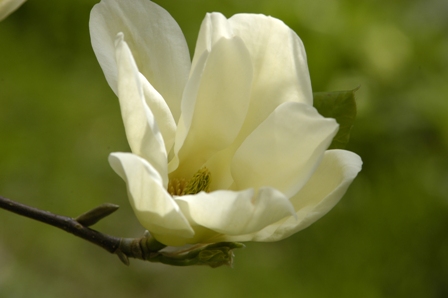
A.’ELIZABETH’– (M.acuminata (American) x M.denudata (Chinese))
This cross was made in the Brooklyn Botanic Garden in 1956. A clone was selected and named in 1978 in honour of Elizabeth Scholz, the Director. It is said to only grow to about 20 feet, but the first plant to come to the UK which is at Wisley, is already taller than this and our own plant at Caerhays is showing promise in this department too. Magnolia denudata is not one of the most startling of the species. Its flowers are white and only occasionally tinged pink or purple at the base. M.denudata is however very hardy and fairly late flowering and is in many ways the opposite hardiness wise to M.acuminata. In maturity M.’Elizabeth’ most closely resembles M. acuminata with its dark green elliptic foliage which is tinged bronze at first. Its flowers however more closely resemble M.denudata with their spreading tulip shape which is intermediate between the two. The flowers have little scent but attractive red stamens. The plant received an Award of Garden Meritin the UK in 1993 but, before we all get too carried away with the excitement of a ‘yellow magnolia’, it should be pointed out that Elizabeth is only really yellowish in bud. Once out it quickly fades to creamy white. In addition the leaves do appear at the same time as (or very soon after in dry weather) the flowers. A good start in the quest for the yellow magnolia but still leaving a great deal more to achieve.
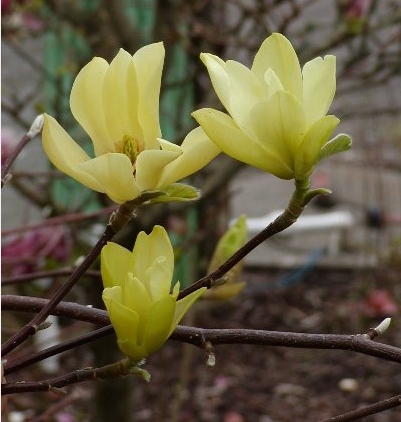
B.’BUTTERFLIES’ – (M.acuminata x M.denudata ‘Sawada’s Cream’)
Second up, in the UK at least, for the contest to develop the “true” yellow magnolia is Magnolia ‘Butterflies’. At Caerhays we cannot see much difference between M.’Elizabeth’ and M.’Butterflies’ although both were originally gifts from the International Magnolia Society. Some would argue that the Caerhays ‘Butterflies’ is not true to name and should have much thinner and more inverted petals. However the flowers on the Caerhays plant are a bit variable and some have more of a M.subcordata – like shape. What is apparent is that the first time out flowers of ‘Butterflies’ are a little more yellow than ‘Elizabeth’ but our mature plant fades off to cream even more quickly. The timing of the arrival of the leaves in the midst of flowering (if you are lucky) is much the same as ‘Elizabeth’. So we have a good floriferous garden plant with what was described in the 1980’s as a ‘precocious yellow cultivar’. Even allowing for the fact that the plant may perform better in the US than here it is hardly a ‘precocious’ yellow as a few days into flowering as it fades to cream.
4.THE SECOND GENERATION YELLOWS
More variations on the theme of yellow were soon being tried out by breeders and we next find in the 1990’s in the UK:-
A.’MISS HONEYBEE’– (a named form of M.acuminata var.subcordata)
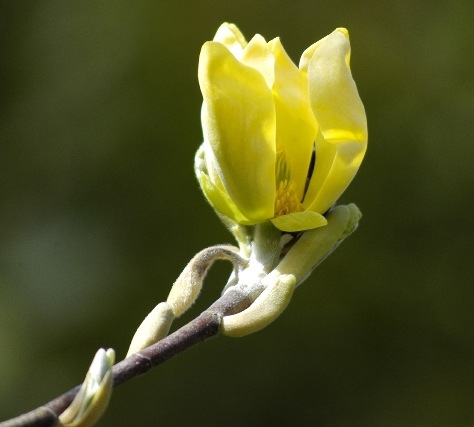
This is really quite a peculiar and slow growing magnolia which, disappointingly, produces its flowers long after the leaves are fully formed. However, the flowers, which are on the small side and have uneven and almost misshapen petals, are definitely a genuine yellow and definitely have a nice scent. Clearly this cultivar will have an important role to play in getting the ‘yellow’ into yellow magnolias but it is not , in itself, anything that exceptional when compared to the majestic grace of a 100foot tall M.campbellii in full flower from top to bottom with a clear blue sky behind it.
B.’GOLD STAR’ –(M.acuminata subsp.cordata’Miss Honeybee’ x M.stellata)
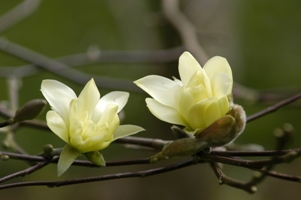
This cross was never likely to create a world beating yellow because M.stellata is of course white. Nevertheless, another leap forward, and one which has genuinely produced something new and different. The original M.stellata is early into flower at Caerhays and grows only to about 12 – 15 feet although planted in 1875. The ‘Gold Star’ at Caerhays is already that sort of height despite being planted in only 1992. The flowers have lots of petals (unlike ‘Miss Honeybee’) and are a delicate greenish yellow in bud opening briefly yellowish before quickly fading to a creamy white. The flowers appear in mid (magnolia) season which means in Cornwall about mid April or early May. A popular plant perhaps but not one which sets seeds with us so it has limited use in future hybridisation in the UK.
C.’YELLOW FEVER’ – (M.acuminata x M.denudata)
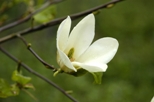
This hybrid was registered in Louisiana in about 1980 but did not make it to the UK until the 1990’s when it appeared on the lists of New Zealand magnolia nurseries and thence to the UK (Direct magnolia imports from the US to the UK are currently fraught with difficulty, if not impossible, due to the problems of Sudden Oak Death in California and Ohio). It has a vigorous upright habit and flowers which are bigger and fuller than ‘Miss Honeybee’. If the buds are a good yellow the flowers are not as they quickly fade to cream and, again, the leaves appear to smother the flowers.
D.’YELLOW LANTERN’ – (M.acuminata var subcordata x (M. X soulangeana ‘Alexandrina’))
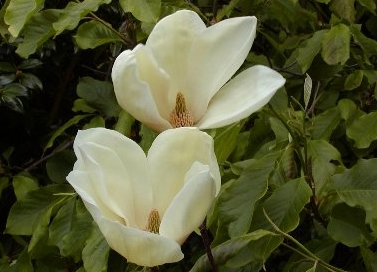
When we first flowered this in the nursery at Burncoose it was in a pot and the flowers, although quite large by (so called) yellow standards, were a rather insipid cream colour. We dismissed it but we were wrong. It is another step along the way to yellowness and has since performed far better in the garden. It has an upright habit, is highly floriferous, and now quite widely available. If you see it in a garden centre don’t get too carried away by the colour label depicting a “duster” yellow flower. In reality it isn’t!
E.’YELLOW RIVER’ – (‘Fei Huang’)
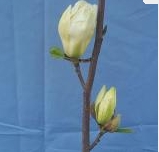
By way of contrast I have added China’s own offering on the yellow magnolia front. This “variety” (and I use the term loosely) started to become widely available about 10 years or so ago initially via the China National Seed Corporation. My personal view is that it is a form of M.denudata which happens to be more yellow in bud than the other more common forms of M.denudata. Once the bud opens the yellowish tinge quickly vanishes, at least in our Cornish climate. The Dutch have clearly shipped this in quantity from China and it is now a big garden centre seller. However, in our opinion, it really isn’t yellow at-all. If I was to stick up for it the plant does have the merit of growing slowly and being suitable for smaller gardens and the leaves do not appear until after the flowers have fallen. This of course proves it has no M.acuminata in its parentage.
F.’YELLOW BIRD’ – (M.acuminata x (M.x brooklynensis’Evamaria’))
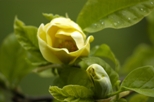
There has to be a winner in the second generation of yellows and there is no doubt in our minds that the ‘Yellow Bird’ is it! I stupidly planted it out in 1997 in an outlying wood at Caerhays where it is very splendid but totally unseen by visitors. With us the flowers nearly always beat the leaves by a healthy margin. The flowers are large, upright and plentiful and, yes, they really can be described as ‘proper’ yellow. This is the first time I dare call a hybrid a ‘good’ yellow. The Americans do not seem to rate it as highly as we do but, if you are only going to buy one ‘yellow magnolia’ that you can trust, to stay at least reasonably “yellow” all the time it is out (yes it fades a bit but not that much) then this is the one to spend your money on.
5. THE THIRD GENERATION, OF YELLOWS _ THE MOST EXCITING NEW INTRODUCTIONS SINCE 2000
While I am very happy for any reader to disagree with my somewhat strident opinions on the various ’yellow’ magnolias investigated above, the plethora of new hybrids currently appearing on the market for us to enjoy and experiment with in our gardens is almost too great to keep up with. I have selected just a few new plants which have performed well with us (albeit often just in pots) at Caerhays and Burncoose. That does not make them show stoppers because we have not grown them or tried them for long enough in different sorts of spring weather to be confident of our conclusions. Nevertheless here goes!
A.’DAPHNE’ – (M.acuminata var subcordata ‘Miss Honeybee’ x M.’Gold Crown’)
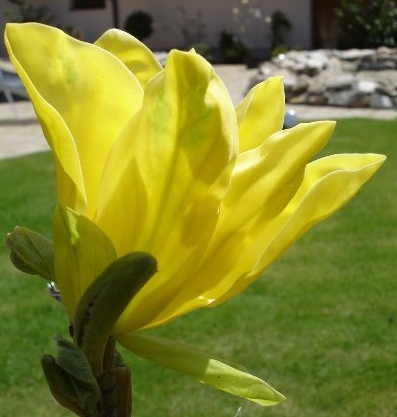
When the renowned Belgian magnolia breeder, Philippe de Spoelberg names one of his hybrids after his wife you can have a safe bet that its a cracker and ‘Daphne’ certainly is! We have 4 plants in the garden at Caerhays but the largest are actually at Burncoose (currently 4 – 5 ft). Yes they do flower usually after the leaves appear, BUT the flowers are long lasting , they stand proud of the leaves at the end of upright stems and they are genuinely yellow from opening to dropping. Philippe tells us that many of the second generation “yellows” are too tender for Belgian winters. He also says some American growers have not done well with ‘Daphne’. All we can say is that it’s the best yet by a long way but the true Mecca is still perhaps 30 -50 years away.
B.’LOIS’ – (M.acuminata x M.denudata)
This Brooklyn Botanic Gardens hybrid was only registered in 1998 but it is certainly keeping the US in the frame against Belgium. The plant received an Award of Merit in 2000 but is still not widely known in the UK. It is definitely a much darker yellow than M.‘Elizabeth’ but very similar in habit and flower size. This has to make it a very good thing!
C.’SUNDANCE’ – (Again! M.acuminata x M.denudata)
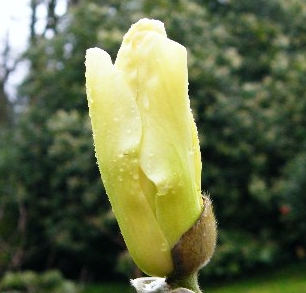
Again we didn’t like this when it first flowered in a pot at Burncoose. We found it a bit insipid but that is often how magnolias perform when they first flower in pots! At Caerhays it started badly just producing the odd flower from a rather small and secretive bud which no one had noticed. Now that the plant is 10 feet tall and growing most vigorously it flowers much more profusely BUT the flowers don’t all come out at the same time so you don’t get a big splash of colour. Yes, the leaves are present again, but this will be a stayer for some time yet in the world of yellows.
D.’STELLAR ACCLAIM’ – (M.x brooklynensis ‘Woodsman’ x M.‘Golden Star’)
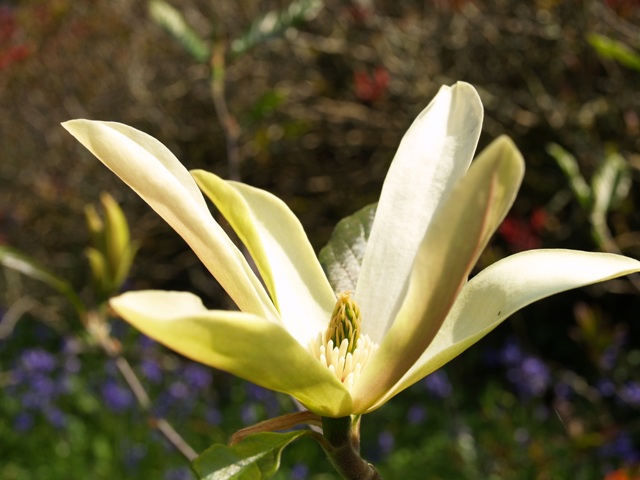
When I first saw the single flower on this plant at Caerhays in 2006 I very nearly took out my secateurs to despatch it humanely. The flower had a greenish hue in bud opening to a rather turgid greenish yellow. Ghastly! I thought. However, I was then reminded by Jaimie Parsons, who is now both Head Gardener and Estate Manager, that we already had a much larger plant at Caerhays which I had never seen in flower because it performed (usually) during the Chelsea Flower Show week when I am always away. When I eventually found the plant on the drive it had about 15 – 20 flowers and very dark green leaves just starting to unfurl. The effect was actually very pleasant and would make a welcome backdrop to an herbaceous border as this does not seem to be (yet at least) too big a grower. Yet again it just goes to show how wrongly one can sum up the first flowering of any magnolia.
E. The list of ‘new’ ’yellows’ is becoming longer and longer but, for the record, you should not dismiss without further vetting:-
– The absurdly (and no doubt marketing agent) named ‘Big Yellow’
– The equally absurdly named ‘Ultimate Yellow’ which, if its colour label is anything to go by, is on the starting rank
– ‘Sunburst’
– ‘Green Bee’ – not a green of course but seemingly a nice thing
– ‘Limelight’ – a bit insipid but perhaps I am being unfair (again)
6.Magnolia x brooklynensis
I had suggested earlier that crossing a pink magnolia with a yellow one might produce a faecal brown or perhaps a stripy surprise!
Before leaving the topic of the perfect yellow magnolia it is perhaps worth digressing to a sideline. M.brooklynensis is a well established cross ( which is attributable to no one for certain and hence the Brooklyn’x’) between M.acuminata and M. lilliflora.
All the forms and new hybrids are small and slow growing trees or large shrubs which make them suitable for smaller gardens. They also have more than a whiff or stripe of yellow somewhere in their flowers although they are the true bastards of the magnolia world in the way that their flowers are such a mixture of colours.
A.’WOODSMAN’
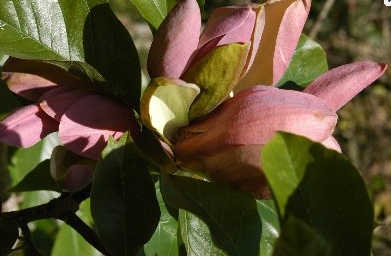
Burncoose first exhibited cut material of this plant at Chelsea in 2002. To our horror it captivated the imagination of magnolia collectors (or worse) and we only (then) had a very few plants to supply lots of orders. ‘Woodsman’ has a fairly disgusting flower. It is black and moderately penile in bud but gradually opening to reveal petals of black-purple, yellowgreen and translucent pink. Pretty horrible by many peoples standards but absurdly different from any other magnolia available today. If you are a (magnolia) fetishist this is the plant for you!
B.’EVAMARIA’
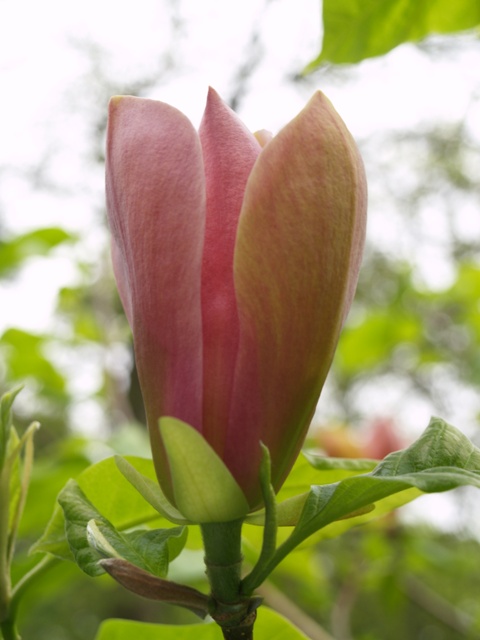
‘Evamaria’
This is a marginally less disgusting, or more agreeable, set of colours depending on your point of view. Basically yellow and green in equal measures when full out and more green than yellow in bud. Yes, the leaves are fully present, but this small tree has an attractive rounded shape which makes it easy enough to see the flowers close to. This used to be a little known form but it is now actually quite popular with the more ‘liberated’ of magnolia growers.
C.’HATTIE CARTHAN’
This one has bright yellow tepals (petals) with magenta mid-veins and the outer tepals have a green hue. Not something you would want to see after a good Saturday night out or a ‘chunder in the thunder’ but there we are! If you like bizarre colours in your magnolia petals (tepals) then this is the boy or girl for you! If however psychedelic colours account for your Sunday mornings plant an avenue of Hattie and you won’t go far wrong.
D.’DAYBREAK’– (M.x brooklynensis ‘Woodsman’ x M ‘Tina Durio’)
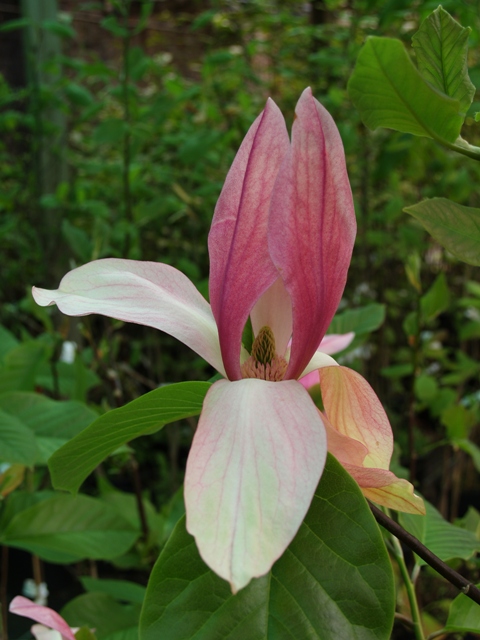
‘Daybreak’
This one is fairly horrid too but certainly unusual in its colour mix and will undoubtedly grow in popularity not least because the Dutch are marketing it avidly. The flowers are basically light rose pink in colour but there is lots of evidence of ‘Woodsman’ on the outer petals which have flashes of green and yellow.
7.THE FUTURE
I must apologise for maligning the work of several expert magnolia breeders with my own personal opinions. However I write not as a botanist but as someone who enjoys magnolias and collects them good, bad or indifferent.
There is no doubt that far too many yellow(ish) magnolias have been named. One breeder in the US tried to name 127 seedlings in 1991. Clearly no one can keep up with this and the quality of the end products have not passed the key tests of both time and the public’s wish to buy.
I have no doubt that the quest for the holy grail of a true spring flowering yellow tree magnolia will be achieved before too long. However there are probably plenty more near misses or ‘nearlys’ to come before we get there.
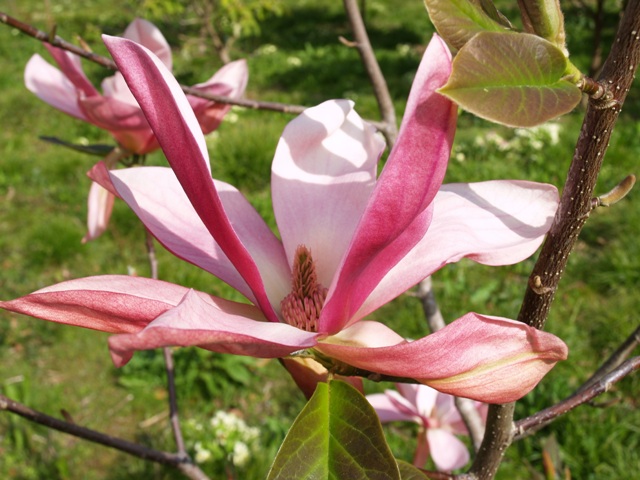
‘Yuchelia’
Two years ago at Caerhays we flowered a Magnolia called ‘Yuchelia’. This is a cross between Magnolia acuminata ‘Miss Honeybee’ and the (evergreen) Michelia figo. As far as I know this is the first marketable example of a previously supposedly impossible cross between a Michelia and a Magnolia. The flower of this plant has the scent of a michelia and basically pink petals which have flashes of green on the outside and are white inside. A wonderful new plant which few people have yet even heard of. If this is the new reality in magnolia hybridisation then the ‘true’ yellow magnolia cannot be very far away.
